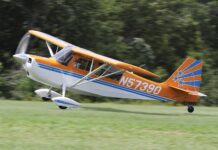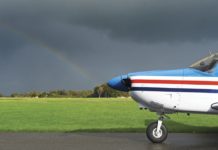Seemingly for generations pilots have argued over which controls speed and which controls altitude: power or pitch. At varying times the FAA contributed support to both sides with publications outlining flying techniques and training information. The very existence of the arguably adolescent-level debates ignores the hard reality: In powered aircraft neither one works alone. To achieve optimum performance in any setting requires balancing the two to best match the needs of the moment. Different combinations—and different sequences—give us everything from the best climb to the best cruise to the best economy to an optimal descent profile or best-profile for an instrument approach. In all cases, the power equation varies according to the altitude you seek, and the pitch attitude necessary varies with the desired airspeed.

288
Just as an aircraft needs to obtain and maintain a specific pitch angle to match its bank angle in a level turn at any given speed, smooth, coordinated flight requires managing both pitch and power. But before we discuss how best to achieve the desired balance, let’s return to the basics of the impact of pitch and power on a powered aircraft.
In Isolation
One of the most-coveted, best-respected tomes on aviating, Wolfgang Langewiesche’s Stick and Rudder, is approaching 70 years old. That it’s been in continuous publication since it first left the presses in 1944 is a testament to its importance and relevance. Langewiesche’s seminal statement on the issue boils down to this simple mantra: “Pitch to speed, power to altitude.” But thanks to a vacillating regulatory agency and some noteworthy exceptions to Langewiesche’s general accuracy, the debate continues for many, but not all, pilots.
As a result, some of us are firmly entrenched, like so many of today’s political junkies, in one camp or the other. But first, we should consider in isolation what occurs when you change pitch angle or power setting. The realm of non-powered aircraft—sailplanes and hang gliders, for example—presents the most graphic affirmation that pitch serves as the primary airspeed control.
When soaring, machine notwithstanding, pitch is your only control over airspeed—thermals and ridge waves serve as the “engine” to allow soaring machines to climb with, ideally, no change in pitch/airspeed. (When soaring thermals, speed precision is paramount, too much speed hurts climb; too little speed also hurts climb. As with so many things aviation, there’s a sweet spot.) Since we’ve not yet invented the level, dead-stick takeoff, most flying literally motors along on some form of installed power.
So what happens when you change pitch, alone, in an aircraft at equilibrium, in stable flight? You know, when the four forces acting on an aircraft—lift and gravity, drag and thrust—all balance out? Pitching down, of course, increases speed and, without a matching change in power, altitude begins to bleed off. Altitude can also change when, as we said, power remains unchanged but we pitch up—the airplane slows and climbs; pitch down and you descend and accelerate.
Opposites
Now consider the opposite—you leave pitch alone and change power. Power, of course, provides pilots with the luxury of changing altitude almost at will and to span large distances unconcerned with working lift to stay aloft. For any given power setting, the pitch angle determines whether you climb, cruise in level flight or descend. That’s because for every power setting there is a matching pitch attitude—or airspeed—allowing either the conversion of power into more altitude, to faster level flight or to a reduced altitude.
So, what happens when you add power? The airplane generally first accelerates slightly before returning to its trimmed airspeed. But because there’s an excess of power for that airspeed, it also begins to climb at a rate equal to the power added.
And when you reduce power? Pretty much all the opposites: Airspeed will initially slow before the airplane returns to its trimmed airspeed and descends at a rate in proportional to the power reduction. Of course, a pilot cannot fly by power alone—or by pitch only. So in practice, we work both controls together to achieve the harmony of level flight at an efficient airspeed and power setting.
Pitch Plus Power = Change
So, how do pitch and power work together? In practice, we climb at a suitable airspeed, maybe a choice dictated by the need to clear an obstacle or meet ATC instructions. For normal departures and the climb-to-cruise segment, my personal preference for my last airplane was 100 KIAS at 2550 rpm, usually yielding 500 fpm. Once at altitude, power was set per the mission. From here, power was my primary adjustment for small speed changes and pitch for small altitude changes—for example, if ATC asked me to climb or descend for traffic.
Now we’re level in cruise. Without changing the pitch attitude, slowly reduce power 100 rpm or an inch of manifold pressure. What happens? First, deceleration. Then, as the airplane again finds its equilibrium, a gentle descent begins at your level-flight, cruise-power airspeed. Reduce power further and the airplane begins to descend in earnest, all at the cruise-power airspeed. To arrest the descent, of course, simply bring up the power, back to its previous cruise setting. The airplane will return to straight-and-level flight at the previous airspeed. The only difference will be you’ve lost a couple hundred feet of altitude.
Now start trimming the nose up, gradually. If you continue to apply nose-up trim, presuming your airplane has sufficient trim authority, eventually you’ll either stall or arrive at the mush state that is as close to a stall as many aircraft get. The difference? With the same cruise-power setting, the pitch change took you from the fastest the plane can fly to the slowest. Only the pitch attitude was changed. Yes, you gained altitude in the process, because power controls altitude in this scenario, while the airplane progressively slowed as the pitch angle increased.
It’s important to note changes in airspeed (pitch) always require the pilot to adjust power (altitude) if that pilot wants to maintain altitude because of the variation of power required in relation to any given speed. Remember, too, at any given airspeed power determines whether the aircraft maintains its altitude, climbs or descends, but if you seek to hold a constant altitude, power governs airspeed with, again, the appropriate adjustments to pitch.
On The GaUges
Smooth transitions and consistency mark much of the flying we do when training for the instrument rating practical test. During our training we learn about the different approach categories for aircraft, based on their different approach speeds, and the minimum altitudes/visibilities at which we can operate during the final portions of a given procedures. This training teaches us how, for example, to work out an approach for a Category A aircraft using a 90-knot number for everything from the initial approach fix on. The math is simple; so is the timing.
First we learn that to descend at our cruise airspeed we need only reduce power. In this instance, lack of power equates to lack of altitude. If ATC asks us to level off at an interim altitude on our way down to the start of the approach, we need only add back roughly the same power we used in cruise. Alternatively, we can use this interruption to slow to our target approach speed by rolling and pitching to that airspeed and adjusting power only as needed to hold that assigned altitude at the desired airspeed.
Now we’re set at the target airspeed until the next change to the aircraft’s equilibrium—say, by extending landing gear and/or flaps, or a final power reduction, designed to fly the final approach segment.
In aircraft blessed by experiencing little or no pitch change with flaps and gear out, we’ll need more power to hold that altitude—or, if ATC allows, we can let the excess drag pull us down, still at that trimmed airspeed.
If this is an ILS, we’re now on the intercept heading for the localizer and watching for the glideslope needle begin to climbing up to center. From here on, we’re in a near-constant-speed descent using pitch to make fine adjustments and only using power to counter significant wind changes or to level off at a non-precision approach’s MDA lest we speed up and come steaming into the airport environment too fast.
When we break out, we use pitch to adjust for our desired touchdown speed and then, generally, reduce power further to keep us on the visual descent slope.
Done correctly, we fly a perfect example of how pitch controls speed, power controls altitude—and how in real life we’re constantly adjusting both to find the harmony we seek.
Putting It All Together
As noted in many a reference, we mostly use both pitch and power in concert with one another to best achieve our goals and hit our targets. Yes, there are those times when one or the other prevails and the debate is more than merely academic. They mainly include initiating a descent or climb.
But the best pilots tend to adjust both to find the balance they seek—and make those adjustments so smoothly and easily that the enlightened observer would barely notice that both pitch and power were tweaked. And that’s a goal worth some practice time.
Dave Higdon is a veteran aviation journalist and instrument-rated pilot who still suffers the after-effects of the excessive Gs in his youth.



